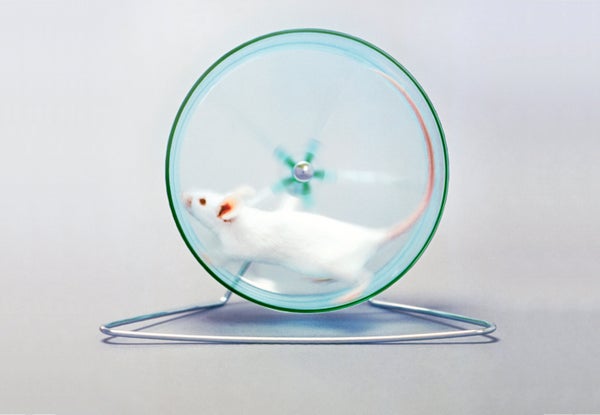Doping scandals have rocked the world of athletics competitions repeatedly. Lance Armstrong’s dramatic fall took his seven Tour de France titles with it, and the BALCO scandal embroiled athletes from professional baseball and football and Olympic track-and-field sports. More recently, the International Association of Athletics Federations, which governs track competitions globally, drew fire after it required Olympic running champion Caster Semenya to medically reduce her testosterone levels if she wanted to compete.
This tension between “antidoping” agencies and elite athletes may notch up a level if findings reported on June 24 in Nature Medicine keep their performance-enhancing promise. Researchers say that proportions of certain bacterial species increase after endurance athletes have completed a marathon. Furthermore, they say, these bacteria break down lactate, also known as lactic acid. which is notorious for bringing on shaky legs after intense exertion. In doing so, they produce another compound, propionate, that might boost endurance.
The study began with an assessment of 15 runners and a comparison of bacterial strains present in their stool before and after they completed the Boston Marathon. The investigators identified a boost in the presence of species the bacterium Veillonella after the marathon, especially Veillonella atypica. They also found that these bacteria were more abundant in the marathoners as compared with 10 nonathletes. These bacteria use lactate and break it down into propionate.
On supporting science journalism
If you're enjoying this article, consider supporting our award-winning journalism by subscribing. By purchasing a subscription you are helping to ensure the future of impactful stories about the discoveries and ideas shaping our world today.
Moving on to another group of athletes, ultramarathoners and Olympic trial rowers, the researchers got similar results: higher levels of Veillonella after an endurance competition. They also found that following the intense physical activity, stool samples from these athletes had higher levels of every bacterial gene involved in breaking down lactate to propionate.
Intrigued by their findings in people, study author George Church, a genetics professor at Harvard University, and his colleagues turned to mice to see what dosing with Veillonella or propionate would do to the animals’ treadmill performance. Oral Veillonella boosted rodent endurance on the treadmill, and rectal administration of propionate did so as well. In addition, the investigators established that lactate can cross from the blood into the gut, where Veillonella might act as a kind of lactate sponge.
The findings are intriguing and support the idea that such bacterial activity can affect exercise function, says Fergus Shanahan, a professor and chair of the department of medicine at University College Cork in Ireland, who was not involved in the work. But he cautions that among elite athletes, these responses likely appear late in the process of becoming superfit and are not necessarily something anyone would see with short-term physical activity.
“Of course, elite athletes will be tempted to leverage this new information to achieve even marginal gain,” Shanahan says, “but we know too little about the microbiome to advocate such a strategy.” Exercise physiologists might want to expand their horizons and consider host-microbe interactions in light of the findings, he adds.
Church says that the next steps include applying a similar approach to evaluate many other biochemicals that are linked to the action of microbes in the gut, some of which might affect immunity or neurological function. In addition to “many experiments left to do,” he says, the researchers are planning to pursue a version of the mouse treadmill study in people.
Church and lead study author Jonathan Scheiman are among the founders of the start-up Fitbiomics. A preliminary version of the findings was presented in 2017 at the American Chemical Society’s national meeting. At that time, Scheiman said in a statement that he hoped the team would have “a novel probiotic on the market” within a year after the company’s launch—a product that has yet to come to market.
The results of these investigations captured the attention of officials at antidoping agencies. “We will continue to eagerly follow those outcomes,” says Matt Fedoruk, chief science officer at the U.S. Anti-Doping Agency, particularly for whether they “unfairly influence competitive results.” Right now, he says, the study is an important first step in identifying possible links between gut bacteria and athletic performance.
The World Anti-Doping Agency (WADA) says that the expert group that develops its “Prohibited List” of substances has yet to even discuss the potential performance-enhancing effects of gut microbiota species and their metabolites. James Fitzgerald, a spokesperson for the agency, says that the list evolves based on new findings and that WADA will pay close attention.
Church, meanwhile, has a different perspective. “Hopefully people will enjoy the pure science for now,” he says, “and keep an eye out for future rigorous clinical trials on consuming specific microbes or biochemicals.”
